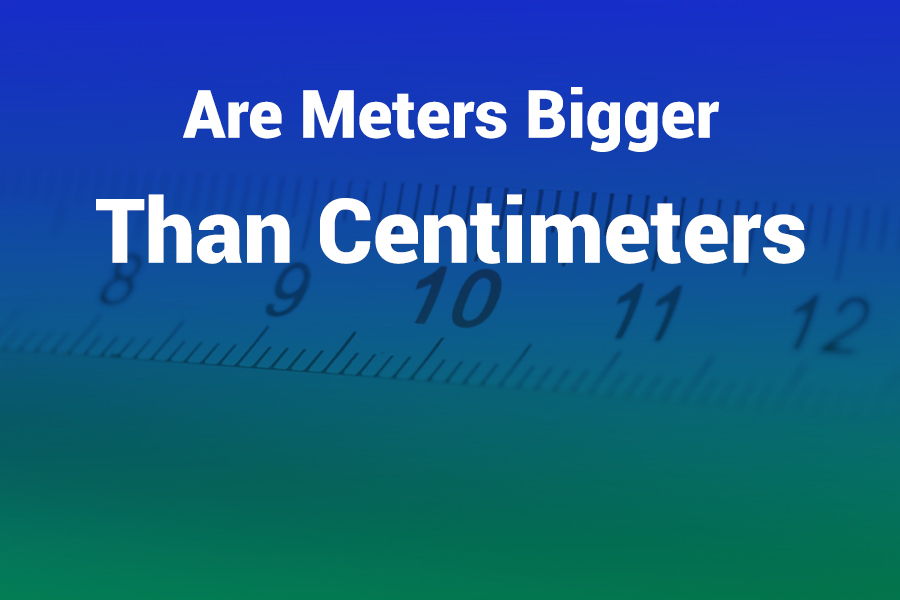Every time you measure something, you choose a unit that fits. But when you see meters and centimeters side by side, you might ask: are meters bigger than centimeters? The short answer is yes.
In this article you will learn exactly how meters compare to centimeters, how to convert between them accurately, real-world contexts where the difference matters, and tips to avoid common mistakes when using metric units.
What Are Meters and Centimeters?
Meters and centimeters belong to the metric system, which uses base units and prefixes to scale up or down by powers of ten.
- A meter (symbol m) is the base unit of length in the International System of Units (SI).
- A centimeter (symbol cm) is a derived unit, defined as one-hundredth of a meter (0.01 m).
The prefix centi- means “hundredth,” so one centimeter equals 1/100 of a meter. That means 100 cm equals 1 m.
Why Meters Are Bigger Than Centimeters
Because one meter equals 100 centimeters, a meter is 100 times larger than a centimeter. In other words, to match the length of 1 m, you’d need 100 individual centimeters.
So in direct comparison:
- 1 m = 100 cm
- 1 cm = 0.01 m
This mathematical relationship makes it clear: meters are bigger than centimeters.
Visualizing the Difference
It often helps to see examples:
- A typical ruler in schools is about 30 cm long, which is only 0.3 m.
- A guitar might measure around 1 m (100 cm) in length.
- A room’s wall might be 3 m tall (300 cm) — far longer than 3 cm.
In daily life, you wouldn’t measure the width of your finger in meters—centimeters suit better. But for room size, meters are more natural.
How to Convert Between Meters and Centimeters
Understanding conversions is essential:
From Meters to Centimeters
Multiply the number of meters by 100:
[ \text{cm} = \text{m} \times 100 ]
Example:
2.5 m × 100 = 250 cm
From Centimeters to Meters
Divide by 100:
[ \text{m} = \text{cm} \div 100 ]
Example:
350 cm ÷ 100 = 3.5 m
You can also multiply by 0.01 (since 1 cm = 0.01 m).
Why Conversions Matter in Science and Daily Life
Accurate conversion between meters and centimeters matters in fields such as:
- Construction and architecture, where error margins can be costly
- Engineering and design, ensuring parts fit correctly
- Medicine and biology, when measuring human growth or specimens
- Education, where students learn metric fluency
A small mistake—like treating 1 m as 1 cm by accident—can cause large discrepancies.
Common Conversion Mistakes to Avoid
- Forgetting the factor of 100: Always remember 1 m = 100 cm.
- Mixing up units: Writing “5 m = 5 cm” is incorrect.
- Misplacing the decimal: 5.00 m = 500 cm, not 50 cm.
Practical Examples That Illustrate “Are Meters Bigger Than Centimeters”
- Compare 1 m and 120 cm
Since 120 cm = 1.20 m, 120 cm is bigger than 1 m. - Compare 4 m and 350 cm
350 cm = 3.50 m, so 4 m is bigger. - Compare 0.75 m and 75 cm
75 cm = 0.75 m, so they are exactly equal.
These examples reinforce that meters can be bigger than centimeters, or equal, depending on value—but the unit meter itself is inherently much larger than the unit centimeter.
Why the Metric System Uses Prefixes
The metric system is designed to scale clearly by tens, hundreds, thousands. Using prefixes like centi-, milli-, kilo- lets us move fluidly between small and large measurements.
- Centi- means 1/100
- Milli- means 1/1,000
- Kilo- means 1,000
So the system remains consistent: meter is the core, and prefixes adjust scale.
Historical and Scientific Definition of the Meter
Modern science defines the meter by how far light travels in a vacuum during a specific time interval (1/299,792,458 of a second). That precise definition ensures that the meter and thus the centimeter are grounded in fundamental constants, giving stability to measurements across science and engineering.
When Might Centimeters Be Better Than Meters?
Although meters are bigger, using centimeters is more practical when precision is needed:
- Tailoring clothing: 5.2 cm vs. 0.052 m is clearer.
- Small parts in electronics: 2 cm feels more meaningful than 0.02 m.
- Biological measurements: leaf, insect, or cell sizes are best in cm or mm.
Meters shine when measuring larger distances: room dimensions, buildings, roads.
Recap: Are Meters Bigger Than Centimeters?
Yes, meters are bigger. A meter is 100 times larger than a centimeter. Understanding this, being able to convert accurately, and using the right unit in context are key to precision and clarity.
Conclusion
Meters and centimeters both measure length, but they serve different scales. A meter equals 100 centimeters, making the meter the bigger unit. When converting, multiply by 100 to go from meters to centimeters, or divide by 100 for the reverse.
In practice, use centimeters for fine detail, meters for broader scale. Mastering this comparison will make your measurements accurate, your math solid, and your communication clear.

